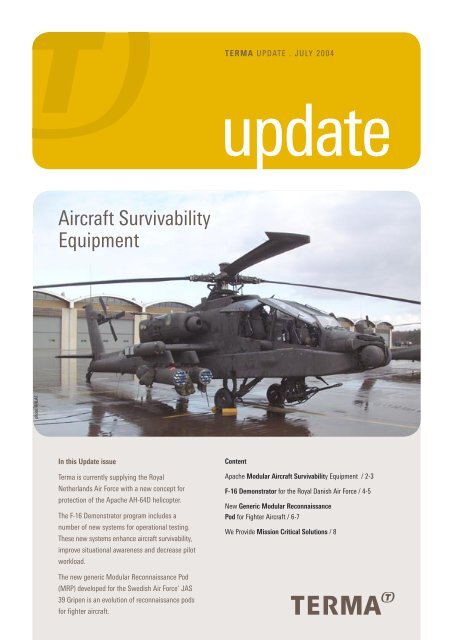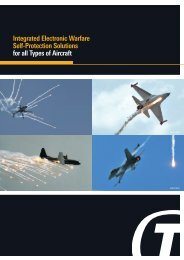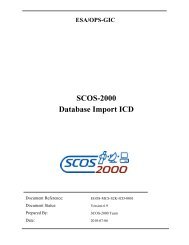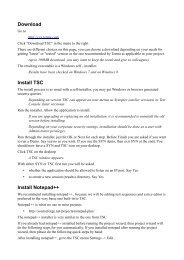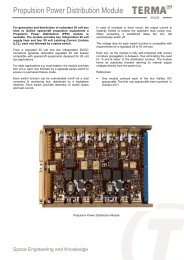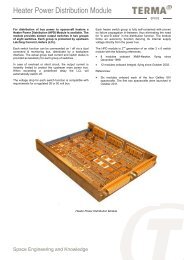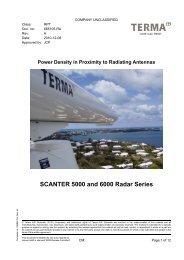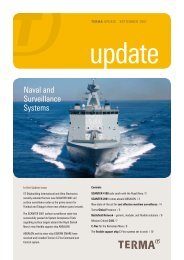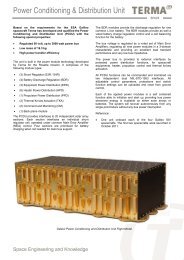July 2004 - terma
July 2004 - terma
July 2004 - terma
Create successful ePaper yourself
Turn your PDF publications into a flip-book with our unique Google optimized e-Paper software.
TERMA UPDATE . JULY <strong>2004</strong><br />
update<br />
Aircraft Survivability<br />
Equipment<br />
photo: RNLAF<br />
In this Update issue<br />
Terma is currently supplying the Royal<br />
Netherlands Air Force with a new concept for<br />
protection of the Apache AH-64D helicopter.<br />
The F-16 Demonstrator program includes a<br />
number of new systems for operational testing.<br />
These new systems enhance aircraft survivability,<br />
improve situational awareness and decrease pilot<br />
workload.<br />
Content<br />
Apache Modular Aircraft Survivability Equipment / 2-3<br />
F-16 Demonstrator for the Royal Danish Air Force / 4-5<br />
New Generic Modular Reconnaissance<br />
Pod for Fighter Aircraft / 6-7<br />
We Provide Mission Critical Solutions / 8<br />
The new generic Modular Reconnaissance Pod<br />
(MRP) developed for the Swedish Air Force’ JAS<br />
39 Gripen is an evolution of reconnaissance pods<br />
for fighter aircraft.
Quick Reaction Contract for<br />
the Royal Netherlands Air Force<br />
In February <strong>2004</strong>, Terma signed a<br />
quick reaction contract with the<br />
Royal Netherlands Air Force (RNLAF)<br />
to supply self-protection equipment<br />
for Apache AH-64D helicopters. From<br />
the signing of the contract to<br />
development, production, and<br />
installation until deployment it took<br />
only four month. The aircraft have<br />
since June been deployed to the<br />
operational theater.<br />
Apache with stub wing<br />
mounted pod of modular<br />
design.<br />
Terma is prime systems integrator<br />
and the RNLAF is responsible for the<br />
installation, which is done at a RNLAF<br />
facility. The operational planning<br />
resulted in a very stringent timeframe<br />
to complete this challenging task.<br />
An Integrated Product Team (IPT)<br />
was quickly pulled together to<br />
ensure a common understanding of<br />
and commitment to objectives and<br />
plans. Before starting the deliveries a<br />
complete System Integration Test was<br />
performed at Terma.<br />
The AMASE (Apache Modular<br />
Aircraft Survivability Equipment)<br />
is an advanced Electronic Warfare<br />
self-protection solution against Infra-<br />
Red (IR) missile threats. Developed<br />
by Terma as a tailor-made system<br />
it is designed to provide optimum<br />
protection for helicopters.<br />
With this new capability, the RNLAF<br />
operate their Apache helicopters at<br />
altitudes sufficiently high to avoid<br />
threats from small arms fire, yet<br />
protected against the most likely<br />
missile threats.<br />
Stub Wing Pods<br />
The AMASE system includes the Terma<br />
developed AN/ALQ-213(V) computerbased<br />
integrated Electronic Warfare<br />
Management System and missile<br />
warning systems and flare dispensers.<br />
The tips of the Apache stub wings<br />
have hard points for the pods. The<br />
Stub Wing Pods contain the Missile<br />
Warning and Flare Dispensing<br />
systems. They are of a modular design<br />
and are located on each side of the<br />
helicopter structure. This position<br />
photo: RNLAF<br />
2 TERMA UPDATE . JULY <strong>2004</strong>
APACHE MODULAR AIRCRAFT SURVIVABILITY EQUIPMENT<br />
photo: RNLAF<br />
of pods has two major advantages;<br />
it is an ideal location for missile<br />
warning sensors as there is very little<br />
shadowing from the aircraft structure<br />
and there is no operational restrictions<br />
on weapons deployment.<br />
A new multifunction color display is<br />
installed to make the pilot aware of<br />
any possible threat. It is driven by a<br />
tactical data unit which at the same<br />
time serves as a recorder for post flight<br />
operational debriefing and analysis. A<br />
complete fault list and maintenance<br />
record is kept at a removable media for<br />
ease of technical maintenance.<br />
Aircraft Survivability Equipment<br />
Terma has previously developed similar<br />
equipment (Aircraft Survivability<br />
Equipment – ASE) for the Dutch<br />
Cougar and Chinook transport<br />
helicopters. In addition, Terma has<br />
supplied electronic warfare equipment<br />
to a variety of fixed wing fighter and<br />
transport aircraft with more than 1,000<br />
systems installed in US fighters.<br />
The pods contain Missile Warning<br />
and Flare Dispensing systems.<br />
The AMASE is an advanced<br />
Electronic Warfare self-protection<br />
solution against IR-missile threats.<br />
A Tactical Data Cartridge is used for<br />
upload of new software and mission<br />
data files.<br />
Facts about EWMS<br />
AN/ALQ-213(V) Electronic<br />
Warfare Management System<br />
Terma’s AN/AQL-213(V) Electronic Warfare Management System (EWMS) was originally<br />
developed for the F-16 in close cooperation with the Royal Danish Air Force for gathering,<br />
processing and presenting information in one coherent system. The equipment has<br />
successfully passed the comprehensive US Foreign Comparative Test (FCT) program.<br />
photo: RNLAF<br />
It replaces individual control panels and indicators for Electronic Warfare (EW), such<br />
as the dispenser, jammer, radar warning and missile warning units. The display and<br />
management unit is placed in a central location within the pilots field of vision and reach.<br />
Terma placed significant emphasis on designing an optimal Pilot-Vehicle Interface (PVI).<br />
The EWMS has been developed into a generic system which fulfills the requirements of<br />
a large number of aircraft types including fighters, helicopters and transport aircraft. As<br />
indicated above the management system integrates, manages, and controls a variety of<br />
EW subsystems.<br />
RNLAF AS-532 Cougar cockpit<br />
with Tactical Threath Display and<br />
Electronic Warfare Management<br />
System.<br />
TERMA UPDATE . JULY <strong>2004</strong> 3
Terma introduces improvements in F-16 Self<br />
Protection and Pilot’s Situational Awareness<br />
Terma is committed to continuously<br />
seek, develop and apply new<br />
technologies, which support pilots in<br />
accomplishing their mission, and<br />
which sees them return safely.<br />
As part of the F-16 Mid-Life Upgrade<br />
(MLU) program, the Royal Danish Air<br />
Force (RDAF) and Terma are working<br />
together to apply state-of-the-art<br />
technologies adding promising new<br />
capabilities which radically improve<br />
the protection of and working<br />
conditions for pilots. This has resulted<br />
in several innovations which now are<br />
integrated for operational trial in an<br />
F-16 Demonstrator aircraft.<br />
Enhanced Aircraft Survivability<br />
A number of new systems have<br />
been installed in the RDAF F-16<br />
Demonstrator aircraft for operational<br />
testing and evaluation purposes. These<br />
new systems enhance<br />
aircraft survivability,<br />
provide in-flight cost<br />
effective training, improve<br />
situational awareness,<br />
and decrease pilot<br />
workload.<br />
The F-16<br />
Demonstrator program<br />
constitutes a unique<br />
opportunity to evaluate<br />
these systems and to<br />
evaluate and improve the pilot-vehicle<br />
interface (PVI) under fierce operational<br />
The Advanced<br />
Threat Display in<br />
semi-triangular<br />
version for the F-16.<br />
conditions. The systems will be<br />
thoroughly tested and evaluated and<br />
the prototype phases will benefit from<br />
these test trials.<br />
The new systems are marketed to all<br />
F-16’s world wide.<br />
All Threats on<br />
one Display<br />
The advanced Tactical<br />
Threat Display<br />
replaces the existing<br />
Radar Warning<br />
Receiver Azimuth<br />
Indicator. It gives the pilot<br />
all important Electronic<br />
Warfare information on<br />
one color display. This<br />
information includes primary threat<br />
warning (radar/missile threats and<br />
4 TERMA UPDATE . JULY <strong>2004</strong>
F-16 Demonstrator for the Royal Danish Air Force<br />
jam indication) and secondary status<br />
indication (mode/health status,<br />
menus/selection and dispenser<br />
inventory).<br />
In-flight Training<br />
Synthetic Electronic Warfare Training<br />
is a self-contained function selectable<br />
at any time during flight and is based<br />
on pilot pre-programmed simulated<br />
threat characteristics. During flight,<br />
threats appear as real threats on the<br />
Tactical Threat Display, enabling the<br />
pilot to activate countermeasures<br />
and maneuver the aircraft like he<br />
would have done in a real situation.<br />
All Electronic Warfare training<br />
sessions are recorded in-flight for later<br />
evaluation. This system provides the<br />
pilot with a training aid that does not<br />
require expensive test ranges with<br />
multiple threat radars.<br />
Missile Warning<br />
The weapon pylons, which have<br />
been updated during the latest block<br />
cycle, are prepared for a field upgrade<br />
to install Missile Warning sensors.<br />
The pylon installed Missile Warning<br />
sensors provide nearly full coverage<br />
of the aircraft for incoming missiles<br />
and alerts the pilot via the Advanced<br />
Threat Display and 3D-Audio. The<br />
system can automatically initiate<br />
countermeasures (ex. flares) which the<br />
pilot then combines with coordinated<br />
maneuvers.<br />
3D-Audio<br />
The purpose of the 3D-Audio system is<br />
for the pilot to quicker become aware<br />
of an emerging threat than what is<br />
achievable using traditional display<br />
technology. The 3D-Audio<br />
system provides a natural<br />
sound using a standard<br />
headset. It allows the<br />
listener to actually perceive the sound<br />
as coming from outside his head<br />
– and from a distinct direction. This is<br />
exactly what we are all used to, when<br />
not using headsets. It allows a pilot<br />
to quickly pinpoint the direction of a<br />
sound, horizontally and vertically, as<br />
well as keeping track of how the sound<br />
moves relative to the aircraft.<br />
Active Noise Reduction<br />
Combined with the above-mentioned<br />
capability or as a stand-alone feature,<br />
Terma has developed an Active Noise<br />
Reduction (ANR) system that has been<br />
installed in the F-16 Demonstrator.<br />
Sensors on the ear cups / helmet are<br />
positioned to pick up noise generated<br />
by the surrounding environment. This<br />
noise is displaced half a wavelength<br />
and impressed on the ordinary audio<br />
signal. The result is a remarkable noise<br />
reduction without loss of the actual<br />
intercom audio. Since the passive<br />
pilot helmet attenuation is poor at low<br />
frequencies (
New generic Modular Reconnaisance Pod<br />
The new generic Modular<br />
Reconnaissance Pod (MRP), which<br />
currently is developed for the<br />
Swedish JAS 39 Gripen, is an<br />
evolution of reconnaissance pods for<br />
fighter aircraft.<br />
Developed by Terma this MRP<br />
provides customers with a maximum<br />
of flexibility in tailoring the sensor<br />
suite to operational requirements for<br />
airborne tactical<br />
reconnaissance.<br />
The pod is conceptually based on the<br />
successful F-16 MRP also developed<br />
by Terma. Due to its generic design<br />
the new MRP can be carried on<br />
various aircraft platforms. It is easily<br />
integrated into the aircraft by a data<br />
bus and a video interface to the<br />
displays in the cockpit.<br />
Rotating Window Section<br />
The MRP employs a circular crosssection<br />
on the lower 180° of the pod<br />
and an advanced rotating section<br />
with a small Infra-Red (IR) translucent<br />
window. Compared to older pod<br />
designs where you either had an<br />
opening into free air or<br />
horizon-tohorizon<br />
windows,<br />
this MRP design takes advantage of<br />
a small IR translucent window. This<br />
design is cost beneficial and gives a<br />
better background for managing the<br />
pod internal environment. The rotating<br />
window section is attached directly<br />
to the MRP strongback and can be<br />
positioned at various positions along<br />
the length of the pod mid-section,<br />
which allows it to accommodate<br />
a variety of different sensors and<br />
caters for variations in pod stuffing,<br />
weight and balance restraints. The<br />
section’s 360° rotation is electronically<br />
synchronized to the sensor aiming –<br />
except for take-off and landing, where<br />
the window is rotated to a position in<br />
the strongback and, thus, providing<br />
protection of the glass during these<br />
phases of the flight.<br />
Facts about the Gripen Pod<br />
Reconnaissance Pod for Swedish<br />
JAS 39 Gripen Fighter Aircraft<br />
In 2001 Terma was awarded a contract with Saab Tech AB of Sweden for the<br />
development and supply of advanced reconnaissance equipment for the JAS 39<br />
Gripen aircraft of the Swedish Air Force.<br />
The contract comprises development and supply of pods and a number of vital<br />
control systems for the complete reconnaissance system. Delivery will take place<br />
during the period <strong>2004</strong> – 2006.<br />
Under contract from prime Saab Tech AB Terma has developed,<br />
qualified and supplied the JAS 39 Modular Reconnaissance Pod (MRP),<br />
including the Environmental Control System, Electrical System, Ground Support<br />
System, and part of the Reconnaissance Management System (RMS) for the<br />
MRP.<br />
6 TERMA UPDATE . JULY <strong>2004</strong>
New Generic Modular Reconnaissance Pod for Fighter Aircraft<br />
Design for Optimum Performance<br />
The upper part of the MRP employs a<br />
square cross-section providing room<br />
for the strongback, ducts for the<br />
environmental control system, cabling,<br />
etc. This ‘hybrid’ concept permits the<br />
main advantages of the MRP, namely<br />
internal pod space and separation<br />
between sensor attachments and<br />
outer fairings required to eliminate or<br />
limit buffeting and dynamic vibrations,<br />
which is very important for the<br />
performance of the sensitive sensors<br />
installed in the pod. Furthermore<br />
the MRP provides the advantages<br />
of a round structure in terms of<br />
aerodynamics and rotating devices.<br />
The nose and tail sections of the<br />
MRP are designed to hold data link<br />
antennas providing the system with an<br />
active role in network centric warfare<br />
operations.<br />
Reconnaissance Management System<br />
The Reconnaissance Management<br />
System, RMS, provides management<br />
and control of all equipment and<br />
functions in the pod. It has a modular<br />
open architecture housed in a chassis<br />
One of the key improvements is the<br />
ability to capture imagery while the<br />
aircraft is maneuvering.<br />
with Commercial-off-the-Shelf (COTS)<br />
Circuit Card Assemblies for I/O<br />
interfaces, communications, computer<br />
and image chain processors.<br />
Facts about the MRP<br />
Intelligence, Surveillance<br />
and Reconnaissance<br />
Terma has provided decision-makers in many Air Forces<br />
with Intelligence, Surveillance, and Reconnaissance (ISR)<br />
equipment. Our systems are built up around a specially<br />
designed Modular Reconnaissance Pod (MRP) which can<br />
accommodate the most common and future sensors. The<br />
MRP contains Management System, Imaging Sensors,<br />
Environmental Control System, Recording Media and all<br />
necessary support.<br />
Terma has delivered reconnaissance systems For F-16 to<br />
Belgium, the Netherlands, the United States and Denmark<br />
including the Tactical Reconnaissance System (TRS) for the<br />
Royal Danish Air Force. The supplying of TRS comprises a<br />
full installation and all integration including cockpit control,<br />
training and logistic support. With its automatic mode<br />
of operation, the system can day and night capture any<br />
geographical location without pilot intervention and thereby<br />
add valuable time to the pilot's primary task of flying the<br />
aircraft. Using the cockpit display, the pilot can verify image<br />
capture and perform a primary assessment of the area of<br />
interest. The system is fully digitized and interfaces with the<br />
aircraft through standard protocols.<br />
Terma supports the development of Standardization<br />
Agreements (STANAG) within the NATO ISR community.<br />
TERMA UPDATE . JULY <strong>2004</strong> 7
TERMA IN BRIEF<br />
Financial Highlights<br />
DKK M 2003/04 2002/03 2001/02 2000/01 1999/00<br />
Sales 1,096 963 1,017 903 871<br />
Sales share abroad 883 804 593 552 596<br />
Profit for the year, before tax 73 60 60 44 50<br />
Equity Capital, year end 320 309 249 238 216<br />
Assets, total 1,131 1,061 933 944 1,055<br />
Order intake 864 1,266 1,076 1,035 602<br />
Order book, year-end 1,450 1,672 1,369 1,311 1,179<br />
Number of full-time employees<br />
– Average for the year 1,010 945 855 850 936<br />
We Provide Mission Critical Solutions<br />
Terma develops and markets high-tech solutions, systems,<br />
and products for civilian and military applications.<br />
Terma A/S headquarters is located in Lystrup near Aarhus,<br />
Denmark. The company is 100 per cent Danish owned.<br />
Terma’s high-tech solutions and products are developed and<br />
designed for use in extreme mission critical environments and<br />
situations, where human lives and valuable material assets<br />
are at stake.<br />
The main business area, Aerospace & Defense, covers:<br />
· Aerostructures for aircraft<br />
· Self-protection systems for aircraft and ships<br />
· Audio system solutions for pilots<br />
· Reconnaissance systems for fighter aircraft<br />
· Command and control systems for navy, army, and air<br />
force applications<br />
· Tactical communication solutions<br />
· Electronics manufacturing<br />
In addition, Terma has business areas within:<br />
· Radar surveillance systems<br />
· Solutions, services and products for space applications<br />
· Air traffic management systems<br />
· IT services<br />
Domestic Terma facilities are located at Lystrup, Grenaa, and<br />
Herlev.<br />
Abroad, Terma locations include Leiden, the Netherlands;<br />
Besozzo, Italy; Weiterstadt near Frankfurt, Germany;<br />
Washington DC, and Warner Robins, GA, USA.<br />
Terma A/S was established in 1949. For many years, Terma<br />
has worked closely with defense forces, public authorities,<br />
and international organizations around the world. Through<br />
these relationships, Terma has gained in-depth knowledge of<br />
and insight into our customers’ working environment and an<br />
equally deep understanding of their situations and needs.<br />
Terma is ultimately owned by the Thomas B. Thrige<br />
Foundation.<br />
TERMA UPDATE . JULY <strong>2004</strong><br />
Terma A/S<br />
Hovmarken 4<br />
8520 Lystrup<br />
Denmark<br />
T +45 8743 6000<br />
F +45 8743 6001<br />
www.<strong>terma</strong>.com<br />
Terma North America Inc.<br />
151 Osigian Blvd., Suites 154<br />
Warner Robins, GA 31088<br />
USA<br />
T +1 478 953 3170<br />
F +1 478 953 3173<br />
Editor<br />
Kasper Rasmussen<br />
kar@<strong>terma</strong>.com<br />
idworks.dk 1408/0704


